Culture of French Polynesia
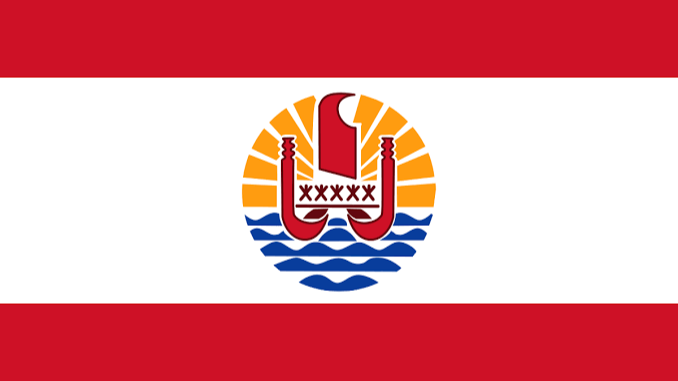
Culture Name
French Polynesian
Orientation
Identification. The Territory of French Polynesia consists of five archipelagoes (Society Islands, Marquesas Islands, Tuamotu Islands, Austral Islands, and Gambier Islands) under French administration. While each island group displays a variant of the Polynesian cultural tradition and all are united by over a century of colonial administration, residents maintain cultural identities specific to the home archipelago and home island. These identities are beginning to blend into a general national identity as a result of modern transportation, education, and communication networks.Location and Geography. French Polynesia includes 121 islands scattered across more than 1,930,500 square miles (five million square kilometers) in the southern Pacific Ocean between Australia and South America. The island groups were formed by undersea volcanoes and include steep volcanic peaks, high islands with fringing coral reefs and large lagoons, and coral atolls surrounding submerged volcanoes. The capital city, Papeete, is on the island of Tahiti, the largest of these islands and the first to experience European conquest.
Demography. The population as of July 2000 is 249,110 on the inhabited islands. Nearly 80 percent of the residents are of Polynesian or mixed Polynesian ethnicity, approximately 12 percent are of European ancestry and 8 percent are of Chinese decent. The population is concentrated in the urban and suburban areas of northern Tahiti, which has nearly 150,000 residents. Only two other islands, Moorea and Raiatea, have populations above ten thousand and many islands have populations below one thousand.
Linguistic Affiliation. A majority of the residents speak both French and Tahitian, the dominant Polynesian language. On the more isolated islands, older residents continue to speak a local Polynesian language; and in the isolated Austral Islands, languages differ from island to island. These languages have become more homogeneous, and Tahitian is beginning to replace local languages. Older Chinese residents speak the Hakka dialect, but younger generations speak French and often Tahitian.
Symbolism. The Territory flies both the French flag and its own flag which shows a red outrigger canoe on a yellow background over a blue sea. The canoe symbolizes the Polynesian seafaring tradition. Other cultural symbols relate to the fertility of the land (the breadfruit), the beauty of the islands (the tiare gardenia blossom and the black pearl), and the indigenous culture (the tiki figure).
History and Ethnic Relations
Emergence of the Nation. The five archipelagoès were joined into a new national entity by the gradual process of French conquest and annexation, beginning with Tahiti in 1843 and ending with the annexation of the Austral group in 1900. French administration and the centralization of authority, jobs, transportation, and services in Papeete contributed to the development of a national identity.
National Identity. French Polynesian identity is more Polynesian than French, but many residents are proud of their relationship to French culture and feel a kinship with French-speaking cultures throughout the world. Residents who favor independence from France advocate a return to a more traditional Polynesian culture.
Ethnic Relations. Tensions between the majority Polynesian ethnic group and the minority European and Chinese communities are due to economic inequalities between those groups and persistent cultural
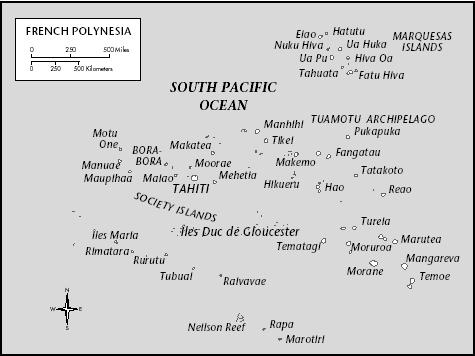
French Polynesia
differences. Violence against members of ethnic minorities is rare, and systematic discrimination against the members of any ethnic group is not evident. There has been a great deal of intermarriage between ethnic groups, and European and Chinese families tend to assimilate into the majority culture.
Urbanism, Architecture, and the use of Space
The only urban center is Papeete and the surrounding communes at the northern end of Tahiti. These are densely developed areas that include a large commercial and government center, military and port facilities, and a wide range of residential housing types. The dominant style of domestic and commercial architecture is International Modern with concrete walls with metal roofs and decorative wood or masonry. Many homes, while built of imported materials, retain traditional spatial organization with a single large sleeping room and an outdoor kitchen. The architecture of public buildings often reflects one of the two regional architectural traditions: Polynesian-style construction from plant materials or colonial construction.
Food and Economy
Food in Daily Life. In rural areas, people provide much of their own food through fishing, animal husbandry, and gardening of indigenous staple foods such as taro, breadfruit, sweet potatoes, and manioc. These local foods are supplemented with imported goods such as rice, canned goods, and fresh bread. In most rural households, only one meal is cooked each day (either lunch or supper) and leftovers are eaten at the other meals. In larger villages and urban areas, Chinese food is available at the local Chinese-owned general store, and in small restaurants. Islands with hotels have restaurants that serve local Polynesian seafood and French-inspired cuisine.
Food Customs at Ceremonial Occasions. On Saturday, Polynesian families prepare an earth oven with traditional foods (fish, pork, taro, breadfruit, sweet potato) to be eaten at large family gatherings on Sunday. Traditional Polynesian food also is served at wedding feasts.
Basic Economy. The economy is heavily dependent on French social programs and military spending. The most important commodity is black pearls, and with the exception of flowers, agricultural exports are insignificant. There is an active internal agricultural trade in which fruits, vegetables, meat, and fish are shipped to market in the urban center from the other islands. Fishing provides some export income, but large-scale commercial fishing is dominated by foreign fleets. Tourism is relatively under-developed, but the jobs and income from tourism are significant on islands that have resorts.
Land Tenure and Property. The contemporary system of land ownership and tenure resulted from French efforts to introduce a system of individual land ownership. Land is inherited equally by all the descendants of a landowner and is often held in common by large groups of related people. Coowners who reside on the family land work out the details of use rights among themselves; these rights are inherited by one's children. Communal land holding is the source of many disputes as heirs petition to divide land into individual holdings or attempt to sell land with competing ownership claims. However, communal ownership has slowed the transfer of land from Polynesian families to recent immigrants. There are few landless Polynesians.
Commercial Activities. A very active import business is dominated by Chinese-Tahitian and French-Tahitian family-owned businesses. Multinational companies are involved in the airline, hotel, construction, and energy sectors, while the importation of building materials, consumer goods, and transport is controlled by local businesses. Locally produced goods include vanilla beans, coconut-oilbased soaps and cosmetics, fruit juice, milk and yogurt, clothing, flowers, and handicrafts.
Major Industries. Within the urban core of Papeete, there are several industrial zones. The port area of Fare includes a number of boat-building and ship-repair businesses, as well as major construction material suppliers. There are only a few factories in French Polynesia: a beer and soft drink bottling enterprise and a few small textile printing studios in Papeete, a fruit juice bottling factory on
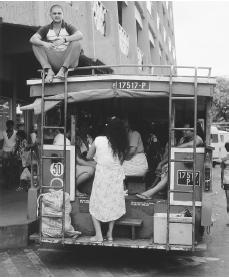
A passenger rides on top of the Papeete bus in Tahiti. Papeete is the only urban center in French Polynesia.
the neighboring island of Moorea, for example. Other major industrial activities include management of landfills, hydroelectric power, and water purification, all of which are government enterprises. Tourism is also an important industry in the Territory (188,933 tourists in 1998).
Trade. Imports of food and other consumer goods including automobiles, appliances, and building materials are enormous by comparison to exports of locally produced commodities. Trade is also entirely by containers shipped by sea into the large port complex of Papeete. Exports of local goods such as black pearls, coconut products, handicrafts, fresh fruit, and flowers are often transported by air. Most trade occurs within the Pacific basin with major trading partners in Taiwan and Hong Kong, Korea, New Zealand, Australia, Chile, Hawaii, and California. A secondary trade market with the European Union is also important but involves luxury goods such as wine, cheese, automobiles, and clothing.
Division of Labor. In general, Polynesian men dominate in skilled and unskilled physical labor (agriculture, construction, fishing, transportation). The retail and commercial sectors are controlled by Chinese and European-Polynesian families. The government sector is the largest source of jobs, with higher-status jobs typically held by European-Polynesian or Polynesian-Chinese residents with university degrees and lower-status jobs held by Polynesians (clerical work by women, public works jobs by men). Political positions and appointments go almost exclusively to Polynesian men.
Social Stratification
Classes and Castes. The class structure closely mimics that of metropolitan France: small upper class, large middle and lower-middle classes, and a small number of poor people. The upper class includes wealthy Polynesian-European families, Chinese merchant families, and foreign residents. The middle class includes members of all ethnic groups. These families typically own their own homes and have at least one wage earner in the household.
The Polynesian hierarchy of ranked titles and chieftainship has disappeared, but Polynesians continue to keep detailed genealogical records and the descendants of chiefly families are aware of their history. The descendants of the Tahitian monarchy are socially prominent.
Symbols of Social Stratification. Class structure is most evident in the display of imported goods such as automobiles and clothing. There is residential segregation of social classes in the urban areas of Tahiti, with oceanfront and ridgetops dominated by the upper classes, the flat littoral plain by middle-class households, and the interior valleys by lower-class households. On the outer islands, house style and size also mark social stratification, while location is less indicative of class.
political Life
Government. The country's official status is an overseas territory of France, with internal autonomy since 1984. The territory manages many of its own affairs while remaining a member of the French republic. The French state controls defense and law and order, foreign affairs, nationality and immigration, justice, higher education, and research, communications, and the currency. Residents vote in national elections and elect representatives to the national government in Paris. The country is responsible for territorial administration, exploration and development rights in certain maritime areas, primary and secondary education, taxation, prices, and foreign trade.
The territory's political institutions are the government of French Polynesia, the Assembly of French Polynesia, and the Economic, Social and Cultural Council (CES). The president and the head of the territorial administration are elected by the Polynesian Assembly from among the forty-one territorial council members. The territorial council members, representing the five archipelagoès are elected by direct universal suffrage every five years. The important units of community government are the commune (municipality) and subcommunes (districts). Each island has a mayor and an elected municipal council. France is represented by a high commissioner. The CES is composed of thirty people representing the professions, the trade unions, and other economic, cultural, and social institutions.
Leadership and Political Officials. Public officials control the resources that flow from the government to local communities. Government agencies, social services, employment, and salaries are under the control of municipal, territorial, and state officials. Political patronage is the dominant feature of regional politics, and residents develop personal ties to officials and manipulate those relationships to gain access to political power.
Military Activity. France tested nuclear weapons at Mururoa Atoll in the Tuamotu Archipelago between 1966 and 1996. In August 1999, France maintained a force of 2,300 military personnel and a police force of six hundred.
Social Welfare and Change Programs
In the early 1960s, an accelerated plan for regional development was introduced that involved the creation of a nuclear testing installation in the Tuamotu Islands and the introduction of a colonial welfare state. Funding for regional development and social programs comes primarily from French taxpayers. Aid, subsidies, and loans from France have created many salaried government jobs for islanders. French Polynesians have a fairly high standard of living that is maintained through the money they receive from French entitlement programs, including the elderly pension/retirement system and the family allocation system. Islanders receive free health care and primary education.
Nongovernmental Organizations and Other Associations
Among the most important voluntary organizations and associations are agricultural associations, church-related groups, craft associations, dance groups, and soccer, canoe, and other sports-related teams. There are a few trade unions.
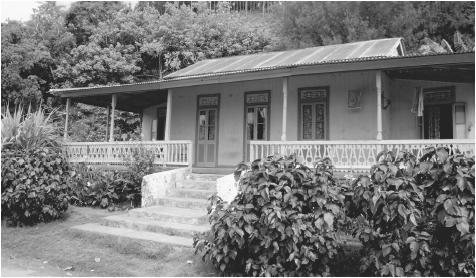
A house on Raivavae, French Polynesia. Traditional homes have a single large sleeping room and an outdoor kitchen.
Gender Roles and Statuses
Division of Labor by Gender. The gendered division of labor resulted from efforts of Christian missionaries and French colonial officials to introduce a Western cultural system. In this system, men were defined as the breadwinners and heads of families and the ideal roles for women were as helpmates and nurturers. Before the introduction of development programs in the 1960s, men were responsible for taro gardens, tree crop plantations, and fishing, and women devoted themselves to motherhood and household maintenance. Women also assisted their husbands in agricultural production and fishing. Men tended to dominate the income-earning opportunities in the processing of copra and vanilla. Rural and urban development schemes after the 1960s expanded men's opportunities in commercial agriculture and introduced wage-earning jobs. Although women in some of the archipelagoès were drawn into wage labor, these opportunities were dominated by men.
The Relative Status of Women and Men. The ability of men to earn money became an essential part of their breadwinning role. After the 1960s, a close association developed between income-earning ability and household decision making. Men's predominance in income-earning activities and greater income were translated into greater control over household decision making. This authority is not supported by an ideology of male superiority. Belief in the interdependence, complementarity, and equality of men's and women's activities and capabilities exists in urban and rural settings.
Marriage, Family, and Kinship
Marriage. Residents recognize several kinds or degrees of marital union. At one end of the continuum is the union of a couple instituted by civil (French) and church ceremonies and celebrated by wedding feasts for relatives, officials, and friends. At the other end are couples that live and eat together without a civil ceremony who are committed to raising a family together and are considered by their neighbors to be married.
Domestic Unit. The most important residential unit is the nuclear family. Many nuclear families include adopted children. Most often couples initially live with the parents of the man or woman and later establish a separate domestic unit.
Inheritance. People recognize bilateral kinship units that control the use of land. Individuals must demonstrate their connections to one of these units in order to claim use rights to plots of family land. Those rights are inherited by one's children.
Kin Groups. All of the mother and fathers' relatives are considered kin. Although not an important corporate or social group in an individual's life, one's bilateral kin group is an important source of mutual aid, and through membership in a kin group, individuals acquire use rights to land.
Socialization
Infant Care. Residents adore children, and most couples look forward to raising a family. Infants and children are raised under the influence of parents as well as grandparents, siblings, and other relatives. Infants are the center of attention in households.
Child Rearing and Education. Children are socialized by a network of kin within and outside the nuclear family household. There is little parental interference in the teaching of skills because people believe in a child's autonomy. The goal is to make children docile so that they will want to act in the "right" way. Children form peer play groups, and much of a child's training takes place in that context.
Higher Education. There is a 98 percent literacy rate. Primary, secondary, and vocational schools were established by the French. Schooling is free and compulsory between ages six and fourteen. Teaching is in French, although a few hours per week of Tahitian are provided in primary and secondary school. Private schools run by churches and subsidized by the government teach the same curriculum as the public schools. Adult education is offered at no charge. French Polynesians can attend college in France or pursue a degree at the French University of the Pacific (UFP), which has a campus in French Polynesia. The geographic fragmentation of the territory complicates the organization of education.
Etiquette
Reciprocity, generosity, and hospitality are central values. When guests are invited for a meal, the hosts are not necessarily expected to eat. Tahitians greet each other by shaking hands and/or exchanging kisses on the cheek. Unless there is a large number of people in the room, it is considered impolite not to shake hands with all of them. It also is considered impolite to keep one's shoes on when entering another person's home.
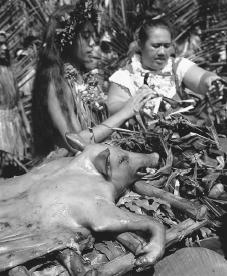
Roasting a pig at a festival in Atuona, Hiva Oa. Rural Polynesians provide much of their own food and generally cook only one meal each day.
Religion
Religious Beliefs. The conversion of residents to Christianity occurred after the London Missionary School sent evangelical Protestant missionaries to Tahiti in 1797. Catholicism was introduced much later by the French. The Catholic population lives primarily in the Gambier and Marquesas archipelagoès. Protestantism predominates in the Society, Austral, and Tuamotu island groups. Today 49 percent of the population is Protestant, 33 percent is Catholic, 5 percent is Mormon, 5 percent is Sanito, and 4 percent is Seventh-Day Adventist.
Before Western contact, people believed in a pantheon of distant gods and a host of local and family spirits that affected daily life.
Many residents believe in ancestral spirits. These spirits gather around the village and are encountered as the ghosts of formerly living people.
Religious Practitioners. In Protestant areas, the Christian faith, the church, and the pastor are central features of village life. Pastors preside over the religious activities of the community, conduct Sunday school, teach the Bible, conduct weddings and funerals, and provide communion. The village pastor is also a protector of community morality and can affect political decision making. Elders have an important power base in the church, and one of their primary roles is to assist the pastor in enforcing social control. Some contemporary villages have indigenous practitioners (primarily male) who use their knowledge and control of spirits and ghosts to heal people who have a spirit-caused disorder.
Rituals and Holy Places. Many rituals involve the events of the Christian calendar year, such as cemetery visiting on All Saints' Day, or the annual re-enactment of the arrival of the missionaries by boat. There are a number of rituals that involve life-cycle events such as baptisms, weddings, and funerals. For example, traditional weddings include the ceremonial presentation of gifts including traditional speech making and dancing. The annual collection of church tithes by the Protestant churches on May Day also involves ritual oratory and ceremonial visitation of local households.
Ancient Polynesian temple platforms, marae , are still considered to be holy places by many Polynesians even though indigenous religious practice has largely ceased. Professional traditional dance companies stage ritual re-enactments of ancient ceremonies on a reconstructed temple platform in the Tahitian district of Paea for tourists and visiting dignitaries.
Death and the Afterlife. Residents traditionally believed that people have both a physical body and a soul. The soul inhabits the body during life, though it can wander during dreaming. Death occurs when the soul leaves the body. Some Christians believe in the existence of two souls. At death, a person's true soul goes to God's world and remains in heaven or hell. A second soul or spirit leaves the body and wanders around the village.
Medicine and Health Care
Health conditions are generally good, with high life expectancy and a low infant mortality rate. In 1998, the major causes of death were cardiovascular problems, cancer, and traumatic injury. Medical care is paid for by the government. There are thirtyfour hospitals and 369 doctors in the territory. Some islands lack a resident doctor. Indigenous medicine is widely utilized despite the recent introduction of Western biomedical techniques. Indigenous healing techniques include the use of herbal medicines, herbal baths, massage, and cupping. Indigenous healing has undergone a revitalization, and associations have developed to protect the heritage of local healing and ensure the authenticity of healers and their practice of local medicine.
Secular Celebrations
Public holidays are 1 January (New Year's Day), 5 March (Arrival of the first missionaries), Good Friday, Easter, Easter Monday, 1 May (May Day), 8 May (V-E Day), the last Thursday in May (Ascension), the first Sunday and Monday in June (Pentecost and Pentecost Monday), 29 June (Internal Autonomy Day), 14 July (Bastille Day), 15 August (Assumption), 1 November (All Saints' Day), 11 November (Armistice Day), and 25 December (Christmas). Other popular holidays are Chinese New Year, the Tahiti festival in July, and the Hawaiki Nui Canoe race.
The Arts and Humanities
Support for the Arts. There are a few formal grant programs, but many artists benefit from patronage relationships with government offices and major institutions. Practitioners of traditional handicrafts may register with the government and eventually receive a partial pension. In general, artists are self-supporting.
Literature. Nearly all fiction is written by expatriate European and Americans. Indigenous Polynesian genres such as storytelling, political and religious oratory, and song writing continue to be popular.
Graphic Arts. French Polynesia attracted many European painters and continues to support painters of island landscapes and residents. Indigenous graphic arts such as sculpture in wood, stone, and coral; the creation of hats, mats, and baskets; tattooing; the making of patchwork quilts; and decorative shell work continue to thrive. The practice of decorating bark cloth has largely disappeared, but several artists are attempting to revive this ancient art form.
Performance Arts. Musical performance genres range from highly stylized hymn singing, to humorous storytelling songs, to popular ballads and local rock and pop music. In addition to "classic" local songs, new songs and music are performed and distributed locally. Musical performance is widely practiced, and a favorite activity is to sit with friends and family after supper and sing old classic ballads as a group, accompanied by ukulele, guitar, and spoons. Traditional drumming is widely practiced, often as an accompaniment to dance performances.
Modern ("disco") dance, local variants of ballroom dances, and traditional Polynesian dance are popular. Traditional dance is performed by many amateur and professional troupes.
The State of the Physical and Social Sciences
There are many scientific institutions and programs. At the national level, the Institut de Recherche pour le Developement has the largest scientific library collection. Territorial research organizations operate under government ministries and include the Institut Rechereches Medicales Louis Mallarde, which conducts medical research on tropical diseases, and the Centre Polynesien de Sciences Humains, the sponsoring organization for archaeology, folklore, and ethnographic studies. A number of organizations are devoted to the marine sciences, including territorial government offices and international institutions as well as visiting research ships. The diversity of scientific institutions reflects the territory's relations with France and well-developed local government. Together with the French University of the Pacific, this combination of national, local, and international scientific organizations conducts research activities.
Bibliography
Elliston, Deborah. "En/Gendering Nationalism: Colonialism, Sex and Independence in French Polynesia." Ph.D. dissertation, New York University, 1997.
Finney, Ben. Polynesian Peasants and Proletarians, 1973.
Hanson, F. Allan. Rapan Lifeways: Society and History on a Polynesian Island , 1970.
Henry, Lisa. The Reconstruction of Tahitian Healing , 1999.
Levy, Robert. Tahitians: Mind and Experience in the Society Islands , 1973.
Lockwood, Victoria. Tahitian Transformation: Gender and Capitalist Development in a Rural Society , 1993.
Oliver, Douglas. Two Tahitian Villages: A Study in Comparison , 1981.
